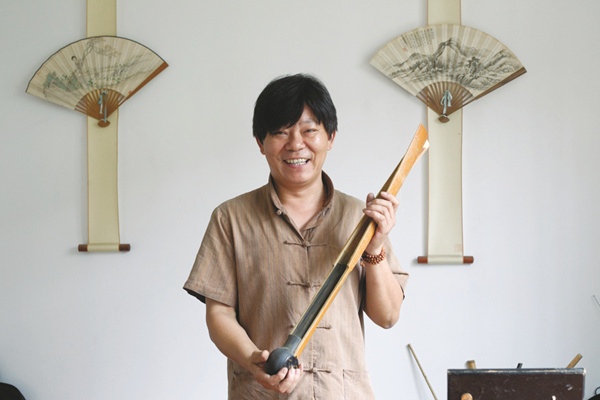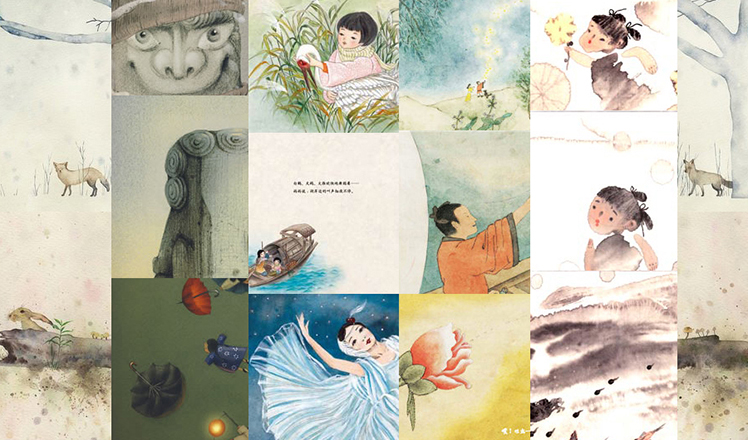Fanning the flames of tradition
Updated: 2016-07-16 04:09
By XU JUNQIAN in Shanghai(China Daily USA)
|
||||||||
 |
 |
|
Wang Jian (up) and Li Jing have each earned acclaim for their work in crafting traditional fans. |
According to historical records, it was the Japanese and Koreans who invented the folding fan. The item later found its way to China when it was given as a tribute to the royal family during the Song Dynasty (960-1279) before gaining popularity early in the 15th century. Unlike in the countries of its origin where it was made for everyday use, folding fans in China were seen as a status symbol and as an objet d'art.
Known as a cradle of literary figures and men of letters, Suzhou has unsurprisingly become a hotbed for the production of exquisite folding fans. There are generally three types of fans available in Suzhou — moon-shaped ones made of silk, those crafted using sandalwood and those folding fans that come with a blank paper cover. The last type is meant exclusively for people to paint or write calligraphy on them. As such, it is often referred to as the "literati's fan" among collectors.
"It's one of the few gadgets in China, if not the world, that requires both skillful craftsmanship and skill in painting, calligraphy and literature. It's not a complete folding fan without either one of the two elements," said Wang of the literati version.
In China, folding fans are hardly ever meant as a means to cool oneself down. There is a strict set of rules on how to unfurl, hold and wave a folding fan. The side of the fan cover that features painting or words, for example, must always face the outside for others to see.
"A folding fan is like a name card. People can learn about its owner just by looking at the signatures on the fan. Factors such as the person who constructed the ribs of the fan, the artist who painted on your fan cover all determine the sort of the person you are. It is kind of like today's social networks, except this takes the form of a material object," said Wang.
Contemporary demand
The latest craze for literati's fans occurred in 2005, the same year Huang Tiancai, an avid collector from Taiwan, organized an auction in Beijing and sold his entire collection of 232 folding fans for a whopping 22.5 million yuan.
The sensational event has since given a massive boost to the popularity of folding fans, which used to have little clout in the antique collection world. The auction is also believed to have renewed interest in the collection of such fan ribs. A year later, a fan rib that is believed to date back to around the 18th century, sold for a record price of 121,000 yuan at another auction.
"People have started to rediscover the value of folding fans, but I don't think they truly understand it yet," said Wang.
As antique fans are scarce, investors began to eye newly-made ones instead, believing that their value would appreciate through time, just like China's aged pu'er tea and eaglewood, or agarwood.
While the prices of folding fans vary greatly from several yuan to several million yuan, those that are priced above 100 yuan have generally seen a general double-digit percentage growth in their value. Factors that affect the price of a fan range from the materials used for ribs — usually ivory, wood and bamboo — to the reputation of its maker.
"Wang Jian's fans are definitely the most pricy. Usually, it's out of the reach of common retailers and buyers," said a fan shop owner in Suzhou, who added that while the premium folding fans are the ones that have always dominated the spotlight, there is a growing "middle class" in the scene who are willing to pay several hundred yuan for a mediocre fan "to play with".
- 8-year-old boy gains 11kg to save father
- China rebuts claim it sank Vietnamese fishing boat
- China on high alert as floods kill 237
- What I want is a healthy grandson, so I will try anything I can
- China calls on US, Japan to stop twisting the facts
- Girl suffers sibling rivalry disorder after younger brother's birth

 Ten photos from around China: July 8-14
Ten photos from around China: July 8-14
 The only surviving panda triplets weaned from milk
The only surviving panda triplets weaned from milk
 First sea-air emergency drill held near Sansha
First sea-air emergency drill held near Sansha
 Truck attack in Nice as France marks national day
Truck attack in Nice as France marks national day
 Picture Chinese stories: 10 illustration books you can't miss
Picture Chinese stories: 10 illustration books you can't miss
 Theresa May: New Iron Lady in Downing Street
Theresa May: New Iron Lady in Downing Street
 Large amount of sea grass besieges Qingdao
Large amount of sea grass besieges Qingdao
 Monks seek tranquility inside lotus ponds
Monks seek tranquility inside lotus ponds
Most Viewed
Editor's Picks

|

|

|

|

|

|
Today's Top News
Ministry slams US-Korean THAAD deployment
Two police officers shot at protest in Dallas
Abe's blame game reveals his policies failing to get results
Ending wildlife trafficking must be policy priority in Asia
Effects of supply-side reform take time to be seen
Chinese State Councilor Yang Jiechi to meet Kerry
Chinese stocks surge on back of MSCI rumors
Liang avoids jail in shooting death
US Weekly

|

|







